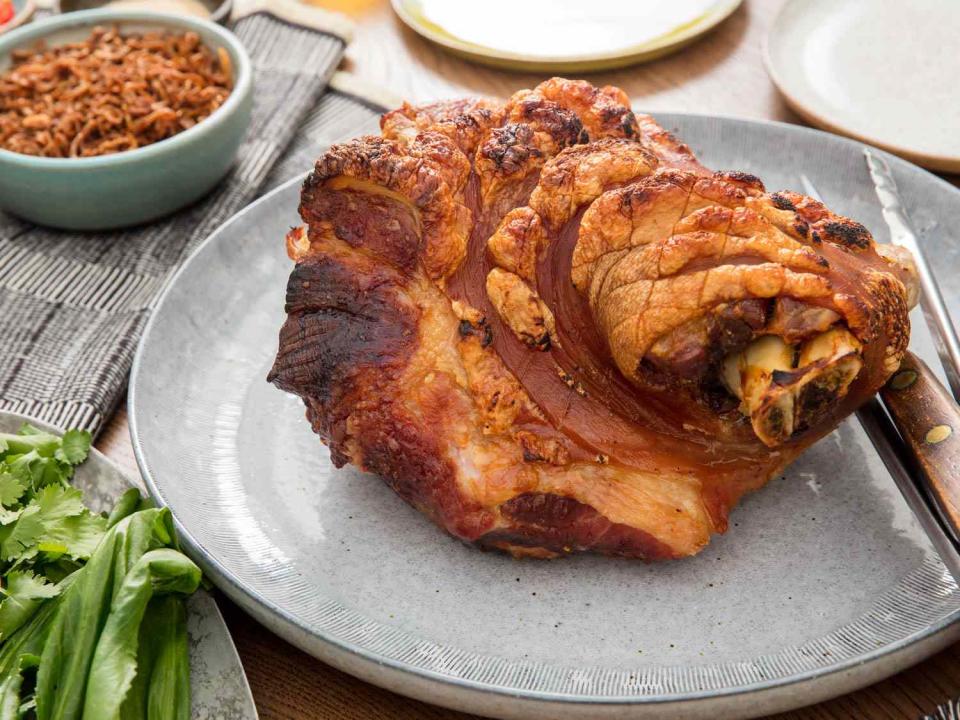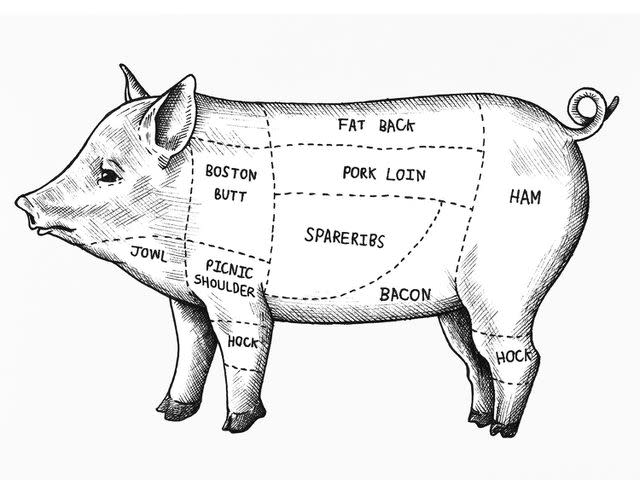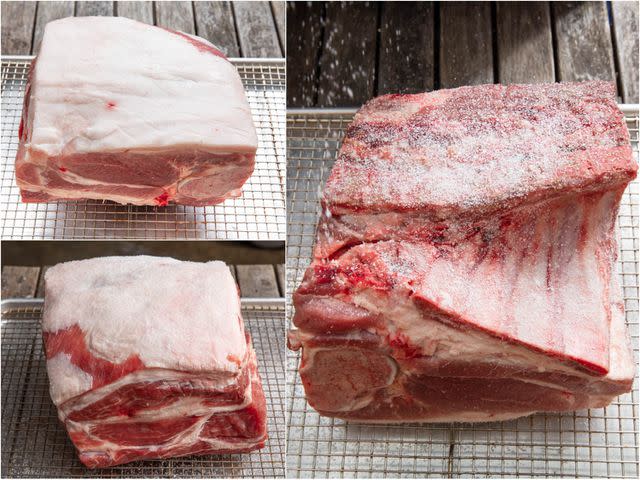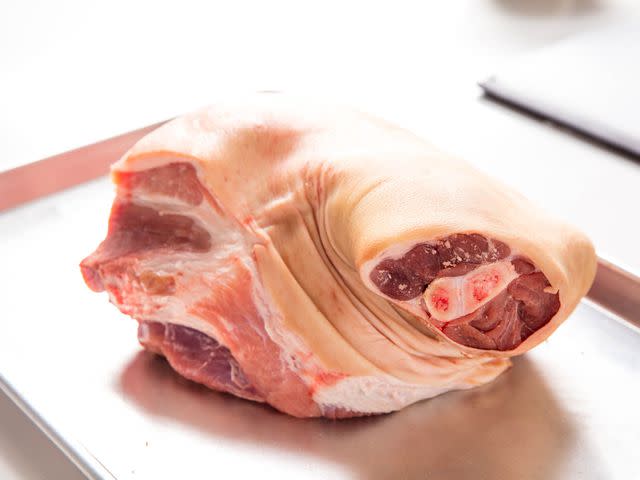Pork Shoulder Demystified: Boston Butt Versus Picnic Shoulder
Shopping for pork shoulder can get confusing fast. Learn the difference between Boston butt and picnic shoulder so you never panic at the butcher's counter again.

Serious Eats / Vicky Wasik
More than once I’ve found myself standing in a butcher shop, staring with confusion at the cold case. Beef and I have a good relationship, and I can point out pork chops, baby back ribs, and pork tenderloins without any trouble. It’s pork shoulder that throws me off, sending me into a frantic internet-searching void until I finally admit to the butcher that I have no idea what I’m looking at. Is the butt the same as the shoulder, or does that enormous hunk of meat come from the animal’s hindquarters? Can I cook a picnic shoulder and a Boston butt the same way? What are all these cuts of meat?
I brought these questions—and more—to our Serious Eats culinary editors, then checked in with Joe Cates, a longtime friend and professional butcher, to end my love-hate relationship with this wonderful yet confusing cut of meat once and for all.
What Is Pork Shoulder?

Serious Eats / Shutterstock
When butchers break an animal down, they separate the largest muscle groups from the body into what are called primal cuts. From these large primal cuts, the animals are further broken down, and divided into the more recognizable cuts that are sold to retail customers.
Pork shoulder is one primal cut; the others are the loin, the belly, and the hind leg. The primal shoulder cut is divided into two sub-primal cuts—picnic shoulder and pork butt, also known as Boston butt.
Yes, you got that right: the butt does not actually come from anywhere near the rear of the animal. In colonial New England, butchers packed inexpensive cuts of meat into large barrels, called butts, for storage and transportation. The shoulder meat packed into these barrels became known as pork butt, and the name stuck. The rear of the animal isn’t referred to as the butt at all—from the pig’s hindquarters, butchers carve fresh hams.
When we talk about roasting pork shoulder, or ask our butcher for three pounds of shoulder meat, we’re often speaking in much vaguer terms than we intend—I’m certainly guilty of this. Unless you’ve taken on the daunting task of cooking an entire 20-pound pork shoulder, you’re either cooking the picnic shoulder or the pork butt.
Though they can be used in many of the same recipes, the butt and the picnic shoulder come from slightly different parts of the animal. They have different degrees of marbling, and one is tougher and more sinewy than the other. Understanding the nuances of these cuts can help you better choose which to buy, and how to cook them both.
What Is Pork Butt (a.k.a. Boston Butt)?

Serious Eats / Vicky Wasik
Sub-primal location: Above the pig’s foreleg and directly behind its head.
How it's sold: Bone-in or boneless, skinless.
Texture: Nicely marbled, moist, and resistant to overcooking.
Uses: Low and slow roast or braised, cut into thin steaks for grilling or searing.
Pork butt comes from above the pig’s foreleg and directly behind its head. This muscle isn’t used as much by the pig as the picnic shoulder—we’ll get to that—so the meat is less tough and sinewy. It’s a nicely marbled, fatty piece of meat, and while it takes well to a low and slow roast or braise, it also adapts well to other preparations: cut it into thin steaks to grill or sear in a hot pan, or truss it up and roast it before slicing the meat into juicy medallions. The pork butt is typically sold in large portions intended for slow cooking, but you can ask your butcher to cut it into bone-in, 1/2-inch steaks if you’re planning to grill it. You can also ask for this cut to be deboned. If you’re going to be shredding or cutting the pork into small pieces—for pulled pork or carnitas, for instance—and you’re tight on time, removing the bone will speed up cooking. Otherwise, pork butt is usually sold bone-in but skinless.
Unless you’re looking for a portion of the shoulder with skin still intact, this is our cut of choice. The pork butt can be used in nearly all of the same applications as the picnic shoulder, but its added marbling renders it more moist and resistant to overcooking. This is the most frequently used cut of meat throughout the South for pulled pork, because of its nice distribution of fat. “When you see competition barbecue,” professional butcher Joe Cates tells me, “they’re nearly always using this cut.” The combination of bone and fat insulates the meat and prevents it from drying out as it cooks for many hours. If you’re looking for a cut that is versatile—able to cook either low and slow or hot and fast—this is the one.
What Is Picnic Shoulder?

Serious Eats / Vicky Wasik
Sub-primal location: Directly below the Boston butt, and includes all of the foreleg until the hock, right above the pig’s front foot.
How it's sold: Bone-in, skin-on.
Texture: Moist, with crispy skin.
Uses: Low and slow cooking.
The picnic shoulder is located directly below the Boston butt, and includes all of the leg until the hock, right above the pig’s front foot. There are some instances where we opt for this cut over Boston butt. The picnic shoulder is almost always sold bone-in and skin-on, and that’s a large part of what makes it so desirable. This portion of the pig gets a lot of use, so the tough muscle requires low and slow cooking—like we do for this Thai-inspired slow-roasted pork shoulder. During cooking, the bone ensures the pork stays moist, while the skin renders, crisps up, and insulates the meat.
Because of the tapered shape of the leg, it can be difficult to cut a picnic shoulder into consistently sized pieces. Because of that, we recommend opting for pork butt when uniform chunks of pork shoulder are called for in a recipe—think stews, like chile verde or carne adovada, and carnitas.
Though pork butt is our choice for most low and slow cooking preparations, and is better when it comes to higher heat and faster cooking as well, the picnic shoulder wins out when we’ve got shatteringly crisp skin on the brain.
July 2019
Read the original article on Serious Eats.

